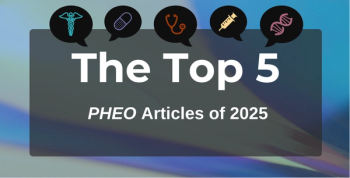
Dr Sanjula Jain: US Health Care Spending “Defies Laws of Economics”
Health care costs continue to rise despite lower demand, while younger generations increasingly face chronic health challenges.
The latest report from Trilliant Health, discussed by Sanjula Jain, PhD, chief research officer at Trilliant Health, revealed
In an interview with The American Journal of Managed Care® (AJMC®), Jain explained how health care spending continues to defy economic principles. Although demand for health care services has remained flat or declined, costs have steadily risen. Meanwhile, a growing number of younger Americans are developing chronic health conditions like obesity, cancer, and behavioral health disorders—trends previously more common among older adults.
Despite increased investments in virtual care, retail clinics, and new therapies, Jain emphasized that the US health care system is struggling to deliver
This transcript has been lightly edited for clarity and length.
AJMC: What are the key takeaways from the overall report, and what does it mean for payers, providers, and patients?
Jain: It's always important to level set the underlying framework for the report and the study at large. I'm a health economist by training, and so a lot of the lens of the main takeaways are really around how health care defies the laws of economics. We start with this question: "How long can we as an industry keep defying those laws?"
What do I mean by defying the laws? In the basic sense, there's a lot of data in the report that talks about demand is actually flat to declining for health care services, which I know sounds a little counterintuitive when we talk about chronic disease and some of the changes in acuity. But when you look at things longitudinally—which is a hallmark of this study—we don't just look at things at a point in time, but [rather] help people understand what are trends that have been consistent for a while or have been accelerated vs something that's really net new. So, when you see demand against the backdrop of supply, what's interesting is that price should go down, but that actually has not happened in our history of health care. And I don't think anybody would argue [against] that American health care is expensive.
This idea that we have these inflated costs or price relative to our supply and demand dynamics just hasn't added up for years. And we call that into question and we say, for the amount of money that we are investing into the US health care system...and that could be sheer dollars from payers such as your government and public entities, but also the private sector, all the innovation that we're investing into the system with new technologies like virtual care, new therapies, and treatment paradigms. The last few years, we've really seen an expansion of choice for consumers. Right now, you're not just limited to going to a doctor's office. You can go to a retail clinic, you can go to urgent care, you can go to telehealth. So, we've invested all of this into the system with good intent, arguably, trying to expand access, provide more coverage to Americans, and lower cost settings.
The fundamental question is, "Are we getting a return on that investment for everything we put into the system?" We would argue the data says no, we are not getting enough output, or rather value, for what we are putting into the system. So, the theme is this concept of, how to optimize the value we're getting out of system vs trying to maximize it. There have been a lot of examples where different stakeholders are focusing on profit maximization for their piece of the health care pie, if you will. But we all need to really take a step back and say, okay, it's not working. We're at this tipping point with the health care system, not just in terms of cost, but Americans are significantly unhealthier today. Something has to give. Something has to change. So, how do we all deliver more value from it?
AJMC: What are the primary drivers behind the disconnect between health care expenditures and patient outcomes, especially in areas like obesity, diabetes, and behavioral health?
Jain: There is one piece that I think is so important to emphasize for the health outcomes portion. We've been talking for years with a lot of research on this about how chronic disease prevalence is on the rise in Americans and all of that. I think what's really important to know what feels different this time around is that it's almost like we've seen a shift in the demographics of Americans that are experiencing these health conditions.
For the first time in our history, we are seeing younger Americans who are historically healthier present with all of these conditions; more mortality and more morbidity in the younger American population. We're talking about 30- and 40-year-olds getting cancer, and excess mortality is really high in this population, and behavioral health is off the chart. Every condition you look at, it's the fact that it's focused on that segment which is really what is jumping off the page, which I think is important to highlight. Because, as you age and as you get older, you have more conditions, and people expect that. But it's not just that people are getting more chronic conditions or they're getting fatter. No, we're seeing the effect on mortality. I mean, that's a pretty scary kind of thing.
To your point about the "why," I have to always preface I'm not a clinician, so I'm sure there's many underlying mechanisms. But, for all the various studies that I read and data that I'm looking at, I think the questions that I think about that may explain some of it—certainly not all of it—is the pandemic certainly had an impact on this. A lot of this is the downstream consequences of what happens when people are locked up at home and have high amounts of stress and anxiety, and working parents have to be at home while also doing childcare and navigating virtual work. That explains some of the anxiety and depression, and then everybody's cooped up at home and [adopting] unhealthy habits, and we saw the Zoom happy hours. Did we start drinking more, and did we start eating more and gaining weight?
All these things compound, and then you also have people not really being proactive about their health in this time period as well. So, there's a lot of societal consequences for this period of time that I think we're now starting to see play out. I think there are other things that we need to explore in terms of just COVID-19 as a disease. What are the longer-term implications of COVID-19 in the body, vaccines, all these things? There could be things that kind of roll together. We're also hearing conversation that some of this isn't net new. Not that all this was triggered by COVID-19. In many ways, it was probably an accelerant. But in America, our food has been more processed for years, and there are more chemicals and all the environmental toxins that we hear a lot about, and there's a lot of discussion happening. There have been a couple of hearings over on the Hill [in Washington, DC,] around our environmental and food quality and how that is actually making us sicker and fatter and all of that. So, it’s a lot of things that are contributing, and I don't think there's one thing that we can do to flip the switch tomorrow to make it all go away, but it's all caught up with us as a country.
AJMC: Do you think we're seeing a new normal with younger generations and how they engage with their health based on the environment they’ve grown up in?
Jain: I don't have the data behind it, but just hypothesizing various factors, I think that we are seeing we live in a new normal. These are generational, societal shifts. In some ways it's like what we read in history books today about what changed after World War I and World War II. We don't even really see it, and that's a big impetus for this report.
We almost have to take a step back. Everybody's talking about artificial intelligence and technology and Ozempic [semaglutide] and everything, but we're so tunnel vision. We don't actually have a sense of, is this good? Is this bad? Has this changed? Are prices going up? Are they going down? We don't have any context. So, yeah, I think that history books are going to be written to say this was the point in time in America's history where A, B, and C happened. And social media is a factor, and you're seeing articles and data points about clothing sizes and all these things. There are just certain things that back in the 80s and 90s were normalized then that are totally changing now.
Everything is cultural and psychological and biological. All of this is converging together, and that's why it's a huge societal issue and that's why I'm so passionate about the study. It would be easy to ignore this because this is just our way of life, but we have to figure out something, because if this trajectory continues, we will bankrupt America. We will hit a point where we cannot deliver the care needed to Americans. We're already dealing with a lot of these tension points, so where's the waste in the system, and where are the opportunities to really have an impact?
It's going to be a big societal grapple, and we could have a whole conversation about the US health care system and other systems, and the kind of American way and philosophy. I'm a big believer in the American way, but that changes our expectations of "I want options, and I want choice, and I don't want to have to wait for anything," which is different than when you talk to people in countries like England and Canada, where they're used to not having choice, and they're okay with that.
And that's back to my economic principles. We don't have a mindset of scarcity. Resources are limited, and ultimately we have to figure out how to do more with less—back to value optimization—and figure out what tradeoffs need to be made to solve X problem. But we have kind of just been throwing more money at various things and not really actually evaluating what effect that is having.
Newsletter
Stay ahead of policy, cost, and value—subscribe to AJMC for expert insights at the intersection of clinical care and health economics.







































